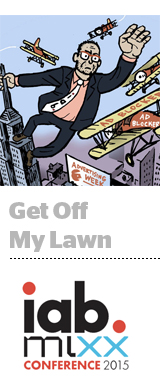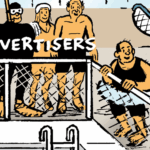 If ad blocking is war, long-tail publishers will likely be its earliest casualties.
If ad blocking is war, long-tail publishers will likely be its earliest casualties.
“Ad blocking is a threat to the whole industry, but it has an especially high impact for the small publishers who make up so much of the rich fabric that is the digital experience,” said Randall Rothenberg, CEO of the Interactive Advertising Bureau, during a speech at IAB MIXX on Tuesday, part of Advertising Week in New York City.
Rothenberg has been feistily vocal over the last couple of weeks on the issue of ad blocking, alternatively calling it an “unnecessary Internet apocalypse” in Ad Age and a “crisis du jour” in The Wall Street Journal.
But ad blocking isn’t quite like the other purported crises facing the industry. While fraudsters are undeniably criminal and viewability is in the midst of getting itself sorted out through industrywide standards, ad blocking remains unique in that crowd because ad blocking is a choice that’s being made by the end user.
“Profiteering software and hardware developers,” as Rothenberg called them, might be the ones creating the tools that enable blocking, but consumers, regular people, are the ones opting to turn them on.
Advertising is what pays the bills at Joyofbaking.com, a mid-size publisher that primarily creates and distributes how-to baking videos. But CEO Rick Jaworski can understand why people are turning to ad blockers, referring to an online article he recently read on why self-starting video ads are often bad for the user experience. And what was at the top of the article? An autoplay video ad.
“I look at ad blocking as a competitive threat, like anyone attacking my business, because they want to get a piece of the pie,” Jaworski said. “But as an industry we’ve gone a little bit overboard on the advertising. Ad blockers have a business to run. I don’t like their business, but we need to remove their model by removing the need for their product.”
Perhaps it’s a matter of education.
Many consumers “don’t make the connection between turning on an ad blocker and cutting off someone’s livelihood,” said Scott Cunningham, SVP at the IAB and general manager of the IAB Tech Lab, which announced a series of initiatives around the ad-blocking issue.
One is the launch of an Ad Blocking Working Group, which is scheduled to hold its first meeting next week. Another is the distribution of code that small publishers can use to detect whether their visitors have ad blocking enabled, thereby giving them the ability to tailor messaging to users who aren’t whitelisting or explain why ads keep the Internet free.
Harking back to the war metaphor, there’s what Cunningham called a “daily battle being waged” between the ad blockers, the larger publishers and ad ops engineers. When publishers create a new ad unit, the open-source ad-blocking community hunts it down and adds it to the block list. Publishers develop tracking script, and the ad blockers sniff it out. It’s a game of cat and mouse that the blockers are happy to keep playing.
But “small publishers don’t have the means to combat this and they’re left hanging,” Cunningham said, explaining the motivation behind the ad blocker detection code, which is about to enter beta testing.
Although publishers can use the code as a means to entreat their ad-blocking visitors, it doesn’t solve the core issue underlying behind why users are blocking ads in the first place.
For many people, advertising is “like a fly buzzing around in their face” while they’re trying to do something, said Peter Imburg, founder and CEO of Elfster, a small social networking site for gift-giving, which generates a good portion of its revenue from advertising.
Ad blocking might be akin to killing that fly with a sledgehammer, but it’s also “a wake-up call,” he said.
“We need to try and solve the things that are annoying to our audience, whether it’s seeing too many ads or messages that make the page load too slowly or ads that take over the page,” Imburg said. “We need to solve those problems so ads become a feature of sites in the long tail – and not just an annoying way to generate revenue.”














